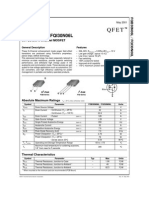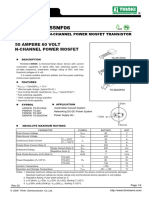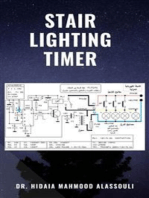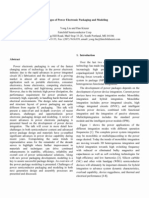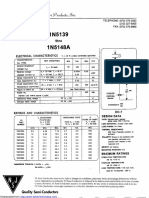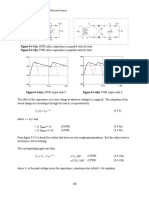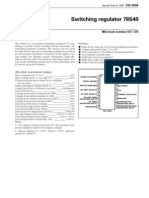NDP6051 / NDB6051 N-Channel Enhancement Mode Field Effect Transistor
NDP6051 / NDB6051 N-Channel Enhancement Mode Field Effect Transistor
Uploaded by
Hoàng Ngọc QuyềnCopyright:
Available Formats
NDP6051 / NDB6051 N-Channel Enhancement Mode Field Effect Transistor
NDP6051 / NDB6051 N-Channel Enhancement Mode Field Effect Transistor
Uploaded by
Hoàng Ngọc QuyềnOriginal Description:
Original Title
Copyright
Available Formats
Share this document
Did you find this document useful?
Is this content inappropriate?
Copyright:
Available Formats
NDP6051 / NDB6051 N-Channel Enhancement Mode Field Effect Transistor
NDP6051 / NDB6051 N-Channel Enhancement Mode Field Effect Transistor
Uploaded by
Hoàng Ngọc QuyềnCopyright:
Available Formats
May 1996
NDP6051 / NDB6051
N-Channel Enhancement Mode Field Effect Transistor
General Description
Features
These N-Channel enhancement mode power field effect
transistors are produced using Fairchild's proprietary, high cell
density, DMOS technology. This very high density process has
been especially tailored to minimize on-state resistance,
provide superior switching performance, and withstand high
energy pulses in the avalanche and commutation modes.
These devices are particularly suited for low voltage
applications such as automotive, DC/DC converters, PWM
motor controls, and other battery powered circuits where fast
switching, low in-line power loss, and resistance to transients
are needed.
48 A, 50 V. RDS(ON) = 0.022 @ VGS= 10 V.
Critical DC electrical parameters specified at elevated
temperature.
Rugged internal source-drain diode can eliminate the need
for an external Zener diode transient suppressor.
175C maximum junction temperature rating.
High density cell design for extremely low RDS(ON).
TO-220 and TO-263 (D2PAK) package for both through hole
and surface mount applications.
______________________________________________________________________________
Absolute Maximum Ratings
T C = 25C unless otherwise noted
Symbol
Parameter
NDP6051
VDSS
Drain-Source Voltage
50
VDGR
Drain-Gate Voltage (RGS < 1 M)
50
VGSS
Gate-Source Voltage - Continuous
20
- Nonrepetitive (tP < 50 s)
ID
Drain Current
NDB6051
40
- Continuous
48
- Pulsed
144
PD
Total Power Dissipation @ TC = 25C
TJ,TSTG
Operating and Storage Temperature Range
TL
Maximum lead temperature for soldering purposes,
1/8" from case for 5 seconds
Derate above 25C
1997 Fairchild Semiconductor Corporation
Units
100
0.67
W/C
-65 to 175
275
NDP6051 Rev. C1
Electrical Characteristics (TC = 25C unless otherwise noted)
Symbol
Parameter
Conditions
Min
Typ
Max
Units
300
mJ
48
250
DRAIN-SOURCE AVALANCHE RATINGS (Note 1)
W DSS
Single Pulse Drain-Source Avalanche
Energy
IAR
Maximum Drain-Source Avalanche Current
VDD = 25 V, ID = 48 A
OFF CHARACTERISTICS
BVDSS
Drain-Source Breakdown Voltage
VGS = 0 V, ID = 250 A
IDSS
Zero Gate Voltage Drain Current
VDS = 50 V, VGS = 0 V
50
mA
IGSSF
Gate - Body Leakage, Forward
VGS = 20 V, VDS = 0 V
100
nA
IGSSR
Gate - Body Leakage, Reverse
VGS = -20 V, VDS = 0 V
-100
nA
TJ = 125C
ON CHARACTERISTICS (Note 1)
VGS(th)
Gate Threshold Voltage
VDS = VGS, ID = 250 A
TJ = 125C
RDS(ON)
Static Drain-Source On-Resistance
2.8
1.4
2.2
3.6
0.018
0.022
0.03
0.04
VGS = 10 V, ID = 24 A
TJ = 125C
ID(on)
On-State Drain Current
VGS = 10 V, VDS = 10 V
gFS
Forward Transconductance
VDS = 10 V, ID = 24 A
60
14
DYNAMIC CHARACTERISTICS
Ciss
Input Capacitance
Coss
Output Capacitance
Crss
Reverse Transfer Capacitance
VDS = 25 V, VGS = 0 V,
f = 1.0 MHz
1220
pF
520
pF
190
pF
SWITCHING CHARACTERISTICS (Note 1)
tD(on)
Turn - On Delay Time
tr
Turn - On Rise Time
tD(off)
VDD = 30 V, ID = 48 A,
VGS = 10 V, RGEN = 7.5
10
20
nS
132
250
nS
Turn - Off Delay Time
28
55
nS
tf
Turn - Off Fall Time
80
150
nS
Qg
Total Gate Charge
37
53
nC
Qgs
Gate-Source Charge
Qgd
Gate-Drain Charge
VDS = 24 V,
ID = 48 A, VGS = 10V
8
22
NDP6051 Rev. C1
Electrical Characteristics (TC = 25C unless otherwise noted)
Symbol
Parameter
Conditions
Min
Typ
Max
Units
DRAIN-SOURCE DIODE CHARACTERISTICS
IS
Maximum Continuos Drain-Source Diode Forward Current
48
ISM
Maximum Pulsed Drain-Source Diode Forward Current
144
VSD
Drain-Source Diode Forward Voltage
0.9
1.3
0.8
1.2
VGS = 0 V, IS = 24 A (Note 1)
TJ = 125C
trr
Reverse Recovery Time
Irr
Reverse Recovery Current
VGS = 0 V, IF = 48 A,
dIF/dt = 100 A/s
35
140
ns
THERMAL CHARACTERISTICS
RJC
Thermal Resistance, Junction-to-Case
1.5
C/W
RJA
Thermal Resistance, Junction-to-Ambient
62.5
C/W
Note:
1. Pulse Test: Pulse Width < 300 s, Duty Cycle < 2.0%.
NDP6051 Rev. C1
Typical Electrical Characteristics
VGS = 12V
2.5
10
9.0
80
60
R DS(on) , NORMALIZED
8.0
7.0
40
6.0
20
5.0
1
V
DS
2
3
4
, DRAIN-SOURCE VOLTAGE (V)
DRAIN-SOURCE ON-RESISTANCE
, DRAIN-SOURCE CURRENT (A)
100
7.0
1.5
8.0
10
40
60
, DRAIN CURRENT (A)
80
100
2.5
I D = 24A
R DS(on) , NORMALIZED
V GS = 10V
1.5
1.25
1
0.75
-25
25
50
75
100
125
T , JUNCTION TEMPERATURE (C)
150
DRAIN-SOURCE ON-RESISTANCE
R DS(ON) , NORMALIZED
DRAIN-SOURCE ON-RESISTANCE
20
TJ = 125C
1.75
1.5
1.25
25C
-55C
0.75
0.5
175
VGS = 10V
2.25
20
40
60
ID , DRAIN CURRENT (A)
80
100
Figure 4. On-Resistance Variation with Drain
Current and Temperature.
Figure 3. On-Resistance Variation
with Temperature.
1.2
T = -55C
J
V DS = 10V
50
25C
V GS(th), NORMALIZED
125C
40
30
20
10
0
2
V GS , GATE TO SOURCE VOLTAGE (V)
Figure 5. Transfer Characteristics.
10
GATE-SOURCE THRESHOLD VOLTAGE
60
I D , DRAIN CURRENT (A)
12
Figure 2. On-Resistance Variation with Gate
Voltage and Drain Current.
0.5
-50
Figure 1. On-Region Characteristics.
1.75
9.0
0.5
VGS = 6.0V
V DS = V GS
I D = 250A
1.1
1
0.9
0.8
0.7
0.6
0.5
-50
-25
25
50
75
100
125
T , JUNCTION TEMPERATURE (C)
150
175
Figure 6. Gate Threshold Variation With
Temperature.
NDP6051 Rev. C1
Typical Electrical Characteristics (continued)
50
20
I D = 250A
I , REVERSE DRAIN CURRENT (A)
1.1
1.05
0.95
V GS = 0V
5
2
1
TJ = 125C
25C
0.1
-55C
0.01
0.001
BV DSS , NORMALIZED
DRAIN-SOURCE BREAKDOWN VOLTAGE
1.15
0.9
-50
-25
0
T
25
50
75
100
125
, JUNCTION TEMPERATURE (C)
150
175
0.0001
0.2
0.4
0.6
0.8
1
1.2
V , BODY DIODE FORWARD VOLTAGE (V)
1.4
SD
Figure 7. Breakdown Voltage Variation with
Temperature.
Figure 8. Body Diode Forward Voltage
Variation with Current and Temperature.
20
CAPACITANCE (pF)
2000
V GS, GATE-SOURCE VOLTAGE (V)
3000
Ciss
VDS = 12V
24V
48V
I D = 48A
15
1000
Coss
10
500
Crss
300
f = 1 MHz
V GS = 0V
200
100
2
V
DS
3
5
10
20
, DRAIN TO SOURCE VOLTAGE (V)
30
50
20
40
Q g , GATE CHARGE (nC)
60
80
Figure 10. Gate Charge Characteristics.
Figure 9. Capacitance Characteristics.
VDD
t on
RL
V IN
t d(on)
VGS
R GEN
DUT
tr
V OUT
t off
t d(off)
tf
90%
90%
VOUT
10%
10%
INVERTED
90%
S
V IN
50%
50%
10%
PULSE WIDTH
Figure 11. Switching Test Circuit.
Figure 12. Switching Waveforms.
NDP6051 Rev. C1
Typical Electrical Characteristics (continued)
300
gFS, TRANSCONDUCTANCE (SIEMENS)
30
TJ = -55C
V DS=10V
100
I D , DRAIN CURRENT (A)
24
25C
18
125C
12
(O
DS
N)
Lim
it
100
50
1ms
20
10m
10
100
VGS = 10V
SINGLE PULSE
o
RJC = 1.5 C/W
T C = 25C
5
2
DC
s
ms
1
0
0.5
0
10
20
I D, DRAIN CURRENT (A)
30
40
Figure 13. Transconductance Variation with Drain
Current and Temperature.
3
5
10
20
30
VDS , DRAIN-SOURCE VOLTAGE (V))
50
70
Figure 14. Maximum Safe Operating Area.
r(t), NORMALIZED EFFECTIVE
TRANSIENT THERMAL RESISTANCE
1
D = 0.5
0.5
0.3
R JC (t) = r(t) * RJC
R
JC = 1.5 C/W
0.2
0.2
0.1
0.1
P(pk)
0.05
0.05
0.03
t1
0.02
0.01
0.02
0.01
0.01
0.02
0.05
t2
TJ - T C = P * R
JC (t)
Duty Cycle, D = t 1 /t2
Single Pulse
0.1
0.2
0.5
2
5
t1 ,TIME (m s)
10
20
50
100
200
500
1000
Figure 15. Transient Thermal Response Curve.
NDP6051 Rev. C1
You might also like
- Luxor LX 285-P - 156-120+Document2 pagesLuxor LX 285-P - 156-120+MihaiNeacsuNo ratings yet
- Modelling A PV Module Using Matlab PDFDocument20 pagesModelling A PV Module Using Matlab PDFluysf548067% (3)
- N Mosfet Fdv303nDocument4 pagesN Mosfet Fdv303nxlam99No ratings yet
- Fds8958A: Dual N & P-Channel Powertrench MosfetDocument11 pagesFds8958A: Dual N & P-Channel Powertrench MosfetbyronzapetaNo ratings yet
- Unisonic Technologies Co., LTD: 8A, 650V N-Channel Power MosfetDocument8 pagesUnisonic Technologies Co., LTD: 8A, 650V N-Channel Power MosfetMarcos RangelNo ratings yet
- FQD2N60C / FQU2N60C: N-Channel Qfet MosfetDocument9 pagesFQD2N60C / FQU2N60C: N-Channel Qfet MosfetTomescu MarianNo ratings yet
- Dual N-Channel, Notebook Power Supply MOSFET: June 1999Document9 pagesDual N-Channel, Notebook Power Supply MOSFET: June 1999dreyes3773No ratings yet
- 7N65 PDFDocument8 pages7N65 PDFboedagbageurNo ratings yet
- DatasheetDocument7 pagesDatasheetrene gonzNo ratings yet
- SMD 357Document6 pagesSMD 357Marcoantonio AntonioNo ratings yet
- FET 75N75 TransistorDocument8 pagesFET 75N75 Transistorshahid iqbalNo ratings yet
- Fds6982S: Dual Notebook Power Supply N-Channel Powertrench SyncfetDocument12 pagesFds6982S: Dual Notebook Power Supply N-Channel Powertrench SyncfetAlejandro DelgadoNo ratings yet
- IRF650B / IRFS650B: 200V N-Channel MOSFETDocument10 pagesIRF650B / IRFS650B: 200V N-Channel MOSFETbinoelNo ratings yet
- Dual N-Channel Enhancement Mode Field Effect Transistor: FeaturesDocument5 pagesDual N-Channel Enhancement Mode Field Effect Transistor: FeaturesBvm BvmmNo ratings yet
- FDMS3604SDocument12 pagesFDMS3604Sg_alinNo ratings yet
- 2N60 PDFDocument7 pages2N60 PDFFady HachemNo ratings yet
- N-Channel Enhancement-Mode Silicon Gate: Semiconductor Technical DataDocument12 pagesN-Channel Enhancement-Mode Silicon Gate: Semiconductor Technical Datameroka2000No ratings yet
- 4 N 60 JJJDocument8 pages4 N 60 JJJnaveed khanNo ratings yet
- FQP12N60C / FQPF12N60C: 600V N-Channel MOSFETDocument10 pagesFQP12N60C / FQPF12N60C: 600V N-Channel MOSFETJose GuerreroNo ratings yet
- Irfr3707Zpbf Irfu3707Zpbf: V R Max QGDocument11 pagesIrfr3707Zpbf Irfu3707Zpbf: V R Max QGJared RobisonNo ratings yet
- Irfp460A, Sihfp460A: Vishay SiliconixDocument7 pagesIrfp460A, Sihfp460A: Vishay SiliconixlyorhitmaNo ratings yet
- Irfp 2907Document9 pagesIrfp 2907Anonymous u8GkNaNo ratings yet
- N-Channel Enhancement Mode Field Effect Transistor: Voltage Package CurrentDocument6 pagesN-Channel Enhancement Mode Field Effect Transistor: Voltage Package CurrentJohn Earl RazoNo ratings yet
- 2N7002 8405Document8 pages2N7002 8405sas999333No ratings yet
- CEF04N6Document5 pagesCEF04N6Armel AtseNo ratings yet
- Power Mosfet THRU-HOLE (TO-254AA) IRFM460 500V, N-CHANNELDocument7 pagesPower Mosfet THRU-HOLE (TO-254AA) IRFM460 500V, N-CHANNELSim AbdeeNo ratings yet
- Fqpf2n70 700v N Chanel MosfetDocument8 pagesFqpf2n70 700v N Chanel MosfetbmmostefaNo ratings yet
- 9N90CDocument8 pages9N90CjostranNo ratings yet
- FQB30N06L / FQI30N06L: 60V LOGIC N-Channel MOSFETDocument9 pagesFQB30N06L / FQI30N06L: 60V LOGIC N-Channel MOSFETsoweloNo ratings yet
- IRF360Document7 pagesIRF360Miloud ChouguiNo ratings yet
- CEF02N6Document5 pagesCEF02N6Zsolt SzoverfiNo ratings yet
- IRF540NDocument7 pagesIRF540Nmichaelliu123456No ratings yet
- 4N65Document8 pages4N65Vicente MalvicaNo ratings yet
- Irf 460Document7 pagesIrf 460Arif SusantoNo ratings yet
- IRFP360LCDocument8 pagesIRFP360LCΗρακλης ΖερκελιδηςNo ratings yet
- 600V N-Channel MOSFET: FeaturesDocument8 pages600V N-Channel MOSFET: FeaturesIldevan José100% (1)
- 50N06 Mosfet Datasheet PDFDocument8 pages50N06 Mosfet Datasheet PDFjoshomecNo ratings yet
- Irfp 260 NDocument9 pagesIrfp 260 NJolaine MojicaNo ratings yet
- Radiation Hardened Power Mosfet THRU-HOLE (T0-204AE) I R H 9 1 5 0 100V, P-CHANNELDocument8 pagesRadiation Hardened Power Mosfet THRU-HOLE (T0-204AE) I R H 9 1 5 0 100V, P-CHANNELDeepa DevarajNo ratings yet
- IRF830A: Smps MosfetDocument8 pagesIRF830A: Smps MosfetRICHIHOTS2No ratings yet
- IRFZ34N Datasheet - KDocument8 pagesIRFZ34N Datasheet - KNairo FilhoNo ratings yet
- Irfps 3810 PBFDocument8 pagesIrfps 3810 PBFCrisan Radu-HoreaNo ratings yet
- Irlr 7843Document12 pagesIrlr 7843Idris LMNo ratings yet
- FQD30N06L / FQU30N06L: 60V LOGIC N-Channel MOSFETDocument10 pagesFQD30N06L / FQU30N06L: 60V LOGIC N-Channel MOSFETJavier Ayerdis NarváezNo ratings yet
- Unisonic Technologies Co., LTD: 30 Amps, 60 Volts N-Channel Power MosfetDocument8 pagesUnisonic Technologies Co., LTD: 30 Amps, 60 Volts N-Channel Power Mosfetperro sNo ratings yet
- Fdw2503N: Dual N-Channel 2.5V Specified Powertrench MosfetDocument6 pagesFdw2503N: Dual N-Channel 2.5V Specified Powertrench MosfetUlises Juan Huancapaza MachucaNo ratings yet
- FQP11N40C/FQPF11N40C: 400V N-Channel MOSFETDocument10 pagesFQP11N40C/FQPF11N40C: 400V N-Channel MOSFETИван АлексиевNo ratings yet
- P 55 NF 06 FPDocument6 pagesP 55 NF 06 FPviki_gpNo ratings yet
- Fds 4488Document5 pagesFds 4488javierrincon800No ratings yet
- Datasheet Mosfet Final RF PDFDocument4 pagesDatasheet Mosfet Final RF PDFVenkatesh KarriNo ratings yet
- FQPF17P06: 60V P-Channel MOSFETDocument8 pagesFQPF17P06: 60V P-Channel MOSFETMahmoued YasinNo ratings yet
- Irf 730 ADocument9 pagesIrf 730 Ajose_mamani_51No ratings yet
- Fdms0308Cs: N-Channel Powertrench SyncfetDocument8 pagesFdms0308Cs: N-Channel Powertrench Syncfetdreyes3773No ratings yet
- IRFB4227Document8 pagesIRFB4227Fco. Jefferson Ferreira de SáNo ratings yet
- N-Channel Enhancement-Mode Silicon Gate: Semiconductor Technical DataDocument8 pagesN-Channel Enhancement-Mode Silicon Gate: Semiconductor Technical Datameroka2000No ratings yet
- 55NF06 MOSFET DatasheetDocument6 pages55NF06 MOSFET DatasheetMunish KaundalNo ratings yet
- Reference Guide To Useful Electronic Circuits And Circuit Design Techniques - Part 1From EverandReference Guide To Useful Electronic Circuits And Circuit Design Techniques - Part 1Rating: 2.5 out of 5 stars2.5/5 (3)
- Reference Guide To Useful Electronic Circuits And Circuit Design Techniques - Part 2From EverandReference Guide To Useful Electronic Circuits And Circuit Design Techniques - Part 2No ratings yet
- High Voltage Direct Current Transmission: Converters, Systems and DC GridsFrom EverandHigh Voltage Direct Current Transmission: Converters, Systems and DC GridsNo ratings yet
- Optoelectronics NotesDocument24 pagesOptoelectronics NotesspeciouskimberlyNo ratings yet
- Mini Project: Solar Powered CarDocument6 pagesMini Project: Solar Powered CarAbhinav SharmaNo ratings yet
- Modulation (AM/DSB/SSB)Document20 pagesModulation (AM/DSB/SSB)Paul MalcolmNo ratings yet
- 5th Sem SyllabusDocument16 pages5th Sem SyllabusabcNo ratings yet
- Snubber Circuit in The Flyback Converter: Transformer Model I L C R + DDocument1 pageSnubber Circuit in The Flyback Converter: Transformer Model I L C R + DdjyNo ratings yet
- NPN AmplifierDocument7 pagesNPN AmplifierAdal MirNo ratings yet
- Unit 1Document41 pagesUnit 1Surya SudhishNo ratings yet
- Diode Laser SDL-B Service ManualDocument55 pagesDiode Laser SDL-B Service ManualSamir FattahNo ratings yet
- Flame ScannersDocument47 pagesFlame ScannersDeepak Gupta100% (3)
- Graduation Project BookDocument116 pagesGraduation Project BookKaffel AhmedNo ratings yet
- Challenges of Power Electronic Packaging and ModelingDocument9 pagesChallenges of Power Electronic Packaging and ModelinglimityyNo ratings yet
- RMAE Notes DIAC TRIACDocument9 pagesRMAE Notes DIAC TRIACPriyanka BhateleNo ratings yet
- Lecture 18 (07-10-2022)Document21 pagesLecture 18 (07-10-2022)Harshaa BattuNo ratings yet
- American International University-Bangladesh (AIUB) Faculty of EngineeringDocument2 pagesAmerican International University-Bangladesh (AIUB) Faculty of Engineeringsowdaga mustafizur rahman0% (1)
- Infrared Shadow Detector With An Alarm EditedDocument56 pagesInfrared Shadow Detector With An Alarm EditedchimaNo ratings yet
- Ec8252 SyllabusDocument1 pageEc8252 SyllabusSarika AyyathuraiNo ratings yet
- Zhu - Yutong ThesisDocument146 pagesZhu - Yutong ThesisSalmi Nour E'ddineNo ratings yet
- II B. Tech I Semester Regular/Supplementary Examinations, October/November - 2018 Electronic Devices and CircuitsDocument8 pagesII B. Tech I Semester Regular/Supplementary Examinations, October/November - 2018 Electronic Devices and CircuitsjaganmohanrsNo ratings yet
- Quality Semi-Conductors: Mln. MaxDocument2 pagesQuality Semi-Conductors: Mln. MaxGuilherme Ribeiro BarbosaNo ratings yet
- 6A MPS, 600 Volts N-CHANNEL MOSFET: FeatureDocument2 pages6A MPS, 600 Volts N-CHANNEL MOSFET: FeatureJose VelasquezNo ratings yet
- Vident iBT100 12V Battery Analyzer ManualDocument11 pagesVident iBT100 12V Battery Analyzer ManualZhang LynnNo ratings yet
- On Semiconductor - mtd20p06hdl-dDocument8 pagesOn Semiconductor - mtd20p06hdl-dshohratNo ratings yet
- Ujt GoodDocument31 pagesUjt GoodRaja ShrivastavaNo ratings yet
- Semi ConductorDocument50 pagesSemi ConductorVibhor KaushikNo ratings yet
- TLE 9 4th QuarterDocument15 pagesTLE 9 4th QuarterMELAIDA CASTANAR GARIBAYNo ratings yet
- Eee 2002 Lecture Notes PDFDocument148 pagesEee 2002 Lecture Notes PDFSatadru DasNo ratings yet
- 1 SWDocument14 pages1 SWNani Chori ShresthaNo ratings yet
- 78S40Document0 pages78S40Pravin MevadaNo ratings yet




























